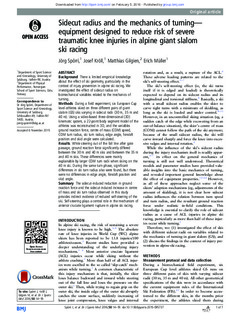| dc.contributor.author | Spörri, Jörg | |
| dc.contributor.author | Kröll, Josef | |
| dc.contributor.author | Gilgien, Matthias | |
| dc.contributor.author | Müller, Erich | |
| dc.date.accessioned | 2016-04-06T08:39:04Z | |
| dc.date.available | 2016-04-06T08:39:04Z | |
| dc.date.issued | 2016 | |
| dc.identifier.citation | British Journal of Sports Medicine. 2016, 50,14-19. | nb_NO |
| dc.identifier.uri | http://hdl.handle.net/11250/2384177 | |
| dc.description | This is an Open Access article distributed in accordance with the Creative Commons Attribution Non Commercial (CC BY-NC 4.0) license, which permits others to distribute, remix, adapt, build upon this work non-commercially, and license their derivative works on different terms, provided the original work is properly cited and the use is non-commercial. See: http://creativecommons.org/licenses/by-nc/4.0/ | nb_NO |
| dc.description.abstract | Background: There is limited empirical knowledge about the effect of ski geometry, particularly in the context of injury prevention in alpine ski racing. We investigated the effect of sidecut radius on biomechanical variables related to the mechanics of turning.
Methods: During a field experiment, six European Cup level athletes skied on three different pairs of giant slalom (GS) skis varying in sidecut radii (30 m, 35 m and 40 m). Using a video-based three-dimensional (3D) kinematic system, a 22-point body segment model of the athletes was reconstructed in 3D, and the variables ground reaction force, centre of mass (COM) speed, COM turn radius, ski turn radius, edge angle, fore/aft position and skid angle were calculated.
Results: While steering out of the fall line after gate passage, ground reaction force significantly differed between the 30 m and 40 m skis and between the 35 m and 40 m skis. These differences were mainly explainable by larger COM turn radii when skiing on the 40 m ski. During the same turn phase, significant differences in ski turn radius also were found, but there were no differences in edge angle, fore/aft position and skid angle.
Summary: The sidecut-induced reduction in ground reaction force and the sidecut-induced increase in centre of mass and ski turn radius observed in this study provides indirect evidence of reduced self-steering of the ski. Self-steering plays a central role in the mechanism of anterior cruciate ligament rupture in alpine ski racing. | nb_NO |
| dc.language.iso | eng | nb_NO |
| dc.publisher | BMJ Publishing Group | nb_NO |
| dc.title | Sidecut radius and the mechanics of turning—equipment designed to reduce risk of severe traumatic knee injuries in alpine giant slalom ski racing. | nb_NO |
| dc.type | Journal article | nb_NO |
| dc.type | Peer reviewed | nb_NO |
| dc.subject.nsi | VDP::Social science: 200 | nb_NO |
| dc.subject.nsi | VDP::Social science: 200::Social science in sports: 330 | nb_NO |
| dc.subject.nsi | VDP::Social science: 200::Social science in sports: 330::Other subjects within physical education: 339 | nb_NO |
| dc.source.journal | British Journal of Sports Medicine | nb_NO |
| dc.identifier.doi | 10.1136/bjsports-2015-095737 | |
| dc.description.localcode | Seksjon for fysisk prestasjonsevne / Department of Physical Performance | nb_NO |
